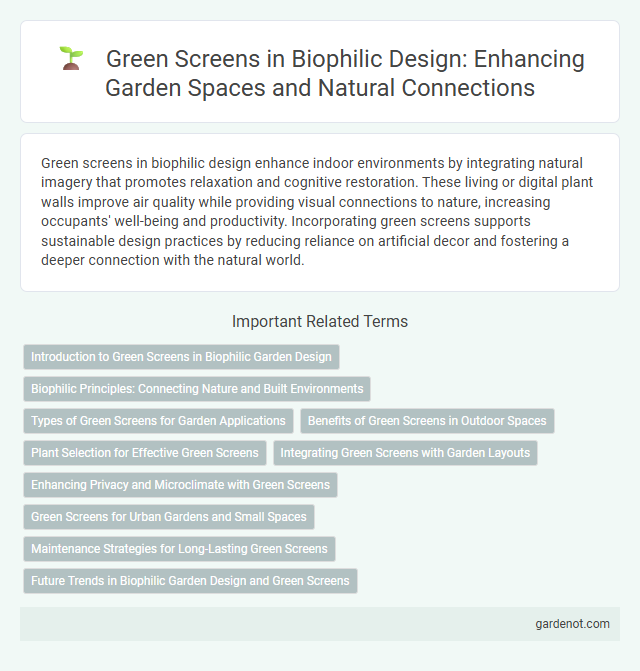Green screens in biophilic design enhance indoor environments by integrating natural imagery that promotes relaxation and cognitive restoration. These living or digital plant walls improve air quality while providing visual connections to nature, increasing occupants' well-being and productivity. Incorporating green screens supports sustainable design practices by reducing reliance on artificial decor and fostering a deeper connection with the natural world.
Introduction to Green Screens in Biophilic Garden Design
Green screens in biophilic garden design serve as living walls composed of climbing plants or modular vegetation panels that enhance spatial aesthetics and promote environmental benefits. These vertical green elements improve air quality, reduce urban heat, and increase biodiversity within built environments. Integrating green screens supports psychological well-being by fostering a closer connection to nature in urban and indoor spaces.
Biophilic Principles: Connecting Nature and Built Environments
Green screens integrate living plants into architectural spaces, enhancing air quality and promoting psychological well-being by mimicking natural ecosystems. These vertical gardens exemplify biophilic design principles by creating seamless connections between indoor environments and nature, fostering sensory engagement and reducing stress. Implementing green screens supports sustainability goals through natural insulation and biodiversity, making buildings healthier and more resilient.
Types of Green Screens for Garden Applications
Green screens for garden applications include living walls, trellis systems, and modular panels, each designed to support climbing plants and enhance outdoor aesthetics. Living walls utilize vertical planting structures integrated with irrigation systems, promoting biodiversity and improving air quality. Trellis systems and modular panels offer flexible installation options suitable for privacy screening, shade creation, and decorative green spaces.
Benefits of Green Screens in Outdoor Spaces
Green screens in outdoor spaces enhance air quality by filtering pollutants and increasing oxygen levels, promoting healthier environments. They provide natural cooling effects, reducing urban heat island impact and lowering energy consumption for nearby buildings. These living walls also improve biodiversity by creating habitats for insects and birds, contributing to ecological balance.
Plant Selection for Effective Green Screens
Selecting the right plant species is crucial for creating an effective green screen in biophilic design, with fast-growing, dense foliage plants like Ficus benjamina, Bamboo, and Hedera helix offering optimal coverage and privacy. Native plants adapted to local climate conditions reduce maintenance needs while enhancing biodiversity and supporting local ecosystems. Incorporating a mix of evergreen and deciduous plants ensures year-round visual interest and seasonal variation in the green screen's appearance.
Integrating Green Screens with Garden Layouts
Integrating green screens with garden layouts enhances vertical planting opportunities, maximizing space and promoting biodiversity in urban environments. These living walls support air purification and temperature regulation, while visually connecting interior and exterior green spaces. Proper placement and selection of native climbing plants ensure seamless integration with existing garden designs, fostering ecological balance and aesthetic harmony.
Enhancing Privacy and Microclimate with Green Screens
Green screens composed of dense foliage and climbing plants significantly enhance privacy by acting as natural barriers that block sightlines while fostering a serene environment. These botanical structures contribute to microclimate regulation by providing shade, reducing heat absorption, and improving air quality through photosynthesis and humidity control. Integration of green screens in architectural spaces supports biophilic design principles by promoting psychological well-being and sustainable urban cooling.
Green Screens for Urban Gardens and Small Spaces
Green screens optimize urban gardens and small spaces by enabling vertical planting and maximizing greenery in limited areas. These structures support climbing plants and vines, promoting biodiversity and improving air quality in dense city environments. Innovative green screens also enhance privacy and aesthetic appeal while contributing to urban heat reduction.
Maintenance Strategies for Long-Lasting Green Screens
Effective maintenance strategies for long-lasting green screens in biophilic design include regular cleaning to prevent dust and debris buildup, ensuring proper irrigation systems to maintain plant health, and routine inspections to identify and address pest or disease issues promptly. Incorporating automated irrigation and humidity sensors enhances consistency in plant care, promoting vibrant and resilient greenery. Selecting low-maintenance, drought-resistant plant species also reduces upkeep frequency while sustaining the green screen's visual and environmental benefits over time.
Future Trends in Biophilic Garden Design and Green Screens
Emerging trends in biophilic garden design emphasize the integration of green screens as dynamic vertical gardens that enhance urban biodiversity and improve air quality. Advanced technologies enable tailored plant selections that maximize environmental benefits while supporting sustainable architecture. These living walls contribute to mental well-being by creating immersive natural environments within increasingly dense cityscapes.
Green screen Infographic

 gardenot.com
gardenot.com